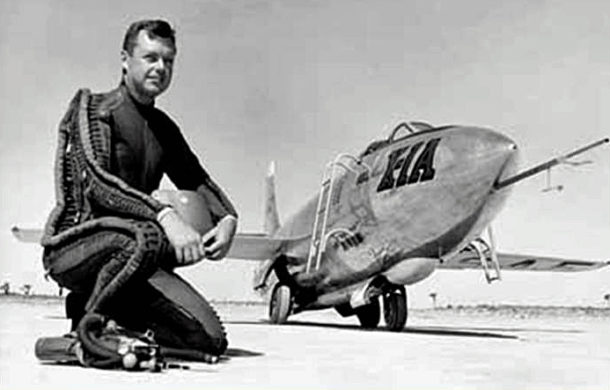
Sixty-two years ago this month, USAF Major Arthur W. “Kit” Murray set a new world altitude record of 90,440 feet in the rocket-powered Bell X-1A. In doing so, Murray reported that he could detect the curvature of the Earth from the apex of his trajectory.
The USAF/Bell X-1A was designed to explore flight beyond Mach 2. The craft measured 35.5 feet in length and had a wing span of 28 feet. Gross take-off weight was 16,500 pounds. Power was provided by an XLR-11 rocket motor which produced a maximum sea level thrust of 6,000 lbs. This powerplant burned 9,200 pounds of propellants (alcohol and liquid oxygen) in about 270 seconds of operation.
Similar to other early rocket-powered X-aircraft such as the Bell XS-1, Douglas D-558-II, Bell X-2 and North American X-15, the X-1A flew two basic types of high performance missions. That is, the bulk of the vehicle’s propulsive energy was directed either in the horizontal or in the vertical. The former was known as the speed mission while the latter was called the altitude mission.
On Saturday, 12 December 1953, USAF Major Charles E. “Chuck” Yeager flew the X-1A (S/N 48-1384) to an unofficial speed record of 1,650 mph (Mach 2.44). Moments after doing so, the X-1A went divergent in all three axes. The aircraft tumbled and gyrated through the sky. Control inputs had no effect. Yeager was in serious trouble. He could not control his aircraft and punching-out was not an option. The X-1A had no ejection seat.
Chuck Yeager took a tremendous physical and emotional beating for more than 70 seconds as the X-1A wildly tumbled. His helmet hit the canopy and cracked it. He struck the control column so hard that it was physically bent. His frantic air-to-ground communications were distinctly those of a man who was convinced that he was about to die.
As the X-1A tumbled, it decelerated and lost altitude. At 33,000 feet, a battered and groggy Yeager found himself in an inverted spin. The aircraft suddenly fell into a normal spin from which Yeager recovered at 25,000 feet over the Tehachapi Mountains situated northwest of Edwards. Somehow, Yeager managed to get himself and the X-1A back home intact.
The culprit in Yeager’s wide ride was the then little-known phenomenon identified as roll inertial coupling. That is, inertial moments produced by gyroscopic and centripetal accelerations overwhelmed aerodynamic control moments and thus caused the aircraft to depart controlled flight. Roll rate was the critical mechanism since it coupled pitch and yaw motion.
In the aftermath of Yeager’s near-death experience in the X-1A, the Air Force ceased flying speed missions with the aircraft. Instead, a series of flights followed in which the goal was to extract maximum altitude performance from the aircraft. USAF Major Arthur W. “Kit” Murray was assigned as the Project Pilot for these missions.
On Thursday, 26 August 1954, Kit Murray took the X-1A (S/N 48-1384) to a maximum altitude of 90,440 feet. This was new FAI record. Murray also ran into the same roll inertial coupling phenomena as Yeager. However, his experience was less tramatic than was Yeager’s. This was partly due to the fact that Murray had the benefit of learning from Yeager’s flight. This allowed him to both anticipate and know how to correct for this flight disturbance.
Murray’s achievement in the X-1A meant that the X-1A held the records for both maximum speed and altitude for manned aircraft. It did so until both records were eclipsed by the Bell X-2 in September of 1956.
Kit Murray was a highly accomplished test pilot who never received the public adulation and notoreity that Chuck Yeager did. He retired from the Air Force in 1960 after serving for 20 years in the military. Murray went on to a very successful career in engineering following his military service. Kit Murray lived to the age of 92 and passed from this earthly scene on Monday, 25 July 2011.

